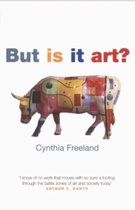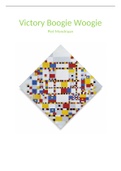Victory Boogie Woogie
Piet Mondriaan
, Piet Mondriaan was born on 7 March 1872 in Amersfoort, The Netherlands. His parents had five
children. In 1880 the family moved to Winterswijk. Mondriaan’s father was headmaster at a primary
school and was an enthusiastic amateur artist. He gave his son drawing lessons. Piet’s uncle Frits
Mondriaan was an artist and taught Piet how to paint. In 1892 Piet enrolled in the Rijksakademie van
Beeldende Kunsten, the National Academy for Visual Arts in Amsterdam. Here he mainly learned
how to copy the paintings of old masters. Once he mastered this skill, he was able to earn money by
copying museum pieces for people (Janssen et al., 2017, p. 13).
From 1905, Mondriaan increasingly followed his own direction in art. From then on, Mondriaan’s
work consisted more of series, meaning paintings with the same subject. Despite the same subject,
every painting is different. This is mainly due to using different painting techniques and the use of
colour. Around 1908, art critics and art lovers, including his father and uncle, no longer liked his
paintings. They thought they were way too colourful. People were used to the paintings of the
Hague School. The artists of The Hague School strove for a more realistic representation of reality.
Nature was observed and painted on the spot. Nature was no longer idealized (Kletter, n.d.).
Mondriaan continued to discover new steps in his painting. At the beginning of 1912, he moved to
Paris where he remained until the beginning of the First World War. Mondriaan was visiting his
family in The Netherlands in 1914 when the First World War started and decided not to return to
Paris. While staying in The Netherlands, criticist Theo van Doesburg and Piet Mondriaan became
very good friends. Theo van Doesburg had published the first edition of the magazine De Stijl in
October 1917. He believed that all things new in art should get a lot more attention. Piet Mondriaan
wrote several articles for De Stijl (Janssen et al., 2017, p. 25).
Mondriaan returned to Paris in 1919 when the First World War had ended. Upon his return,
Mondriaan discovered that his fellow cubist artists took a different course than he had expected.
Mondrian’s art had become more abstract during the war. Music was his inspiration instead of
nature. He wanted to avoid any association with nature and that is why he started using the primary
colours red, yellow and blue in combination with grey, white and black (NTR, 2017). Mondriaan liked
to hang out with Dadaist and Surrealist artists in Paris and he started to paint the black lines with
coloured surfaces. Implementing Dadaism and Surrealism in his art made him world-famous (NTR,
2017).
Mondriaan feels very threatened by the rise of Hitler’s National Socialism in 1933. He wanted to
move to New York in 1938, away from the Nazi’s. He travelled to Calais where, on 21 September
1938, he took the ferry to London. It was a journey towards freedom for him. Instead of continuing
his travels to New York, he stayed in London. He lived in the Hampstead district, an artists’ quarter
Piet Mondriaan
, Piet Mondriaan was born on 7 March 1872 in Amersfoort, The Netherlands. His parents had five
children. In 1880 the family moved to Winterswijk. Mondriaan’s father was headmaster at a primary
school and was an enthusiastic amateur artist. He gave his son drawing lessons. Piet’s uncle Frits
Mondriaan was an artist and taught Piet how to paint. In 1892 Piet enrolled in the Rijksakademie van
Beeldende Kunsten, the National Academy for Visual Arts in Amsterdam. Here he mainly learned
how to copy the paintings of old masters. Once he mastered this skill, he was able to earn money by
copying museum pieces for people (Janssen et al., 2017, p. 13).
From 1905, Mondriaan increasingly followed his own direction in art. From then on, Mondriaan’s
work consisted more of series, meaning paintings with the same subject. Despite the same subject,
every painting is different. This is mainly due to using different painting techniques and the use of
colour. Around 1908, art critics and art lovers, including his father and uncle, no longer liked his
paintings. They thought they were way too colourful. People were used to the paintings of the
Hague School. The artists of The Hague School strove for a more realistic representation of reality.
Nature was observed and painted on the spot. Nature was no longer idealized (Kletter, n.d.).
Mondriaan continued to discover new steps in his painting. At the beginning of 1912, he moved to
Paris where he remained until the beginning of the First World War. Mondriaan was visiting his
family in The Netherlands in 1914 when the First World War started and decided not to return to
Paris. While staying in The Netherlands, criticist Theo van Doesburg and Piet Mondriaan became
very good friends. Theo van Doesburg had published the first edition of the magazine De Stijl in
October 1917. He believed that all things new in art should get a lot more attention. Piet Mondriaan
wrote several articles for De Stijl (Janssen et al., 2017, p. 25).
Mondriaan returned to Paris in 1919 when the First World War had ended. Upon his return,
Mondriaan discovered that his fellow cubist artists took a different course than he had expected.
Mondrian’s art had become more abstract during the war. Music was his inspiration instead of
nature. He wanted to avoid any association with nature and that is why he started using the primary
colours red, yellow and blue in combination with grey, white and black (NTR, 2017). Mondriaan liked
to hang out with Dadaist and Surrealist artists in Paris and he started to paint the black lines with
coloured surfaces. Implementing Dadaism and Surrealism in his art made him world-famous (NTR,
2017).
Mondriaan feels very threatened by the rise of Hitler’s National Socialism in 1933. He wanted to
move to New York in 1938, away from the Nazi’s. He travelled to Calais where, on 21 September
1938, he took the ferry to London. It was a journey towards freedom for him. Instead of continuing
his travels to New York, he stayed in London. He lived in the Hampstead district, an artists’ quarter




